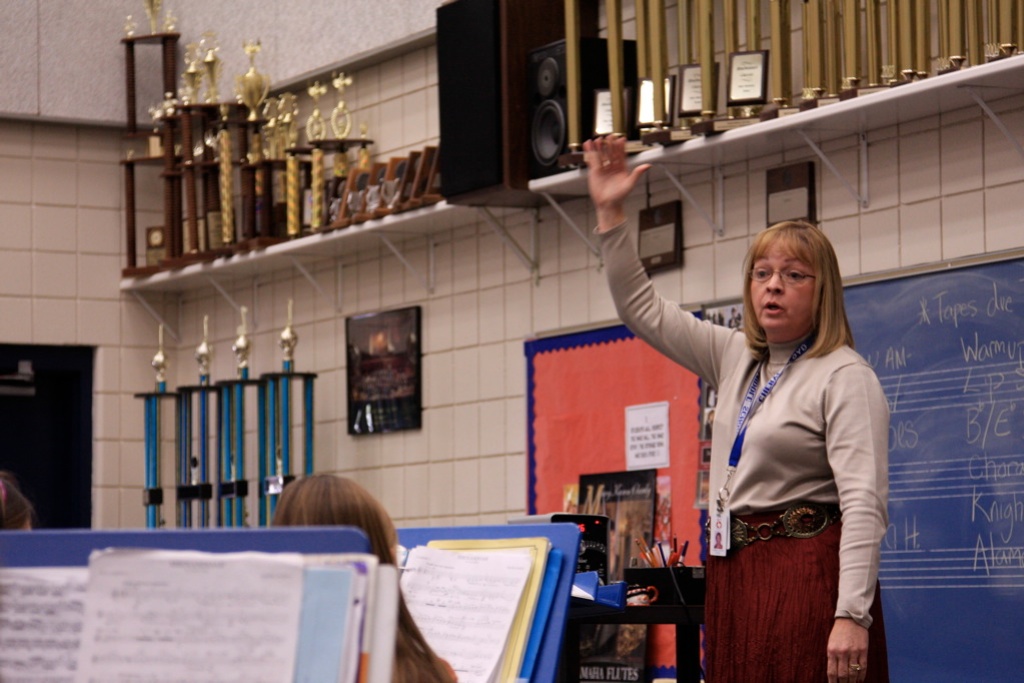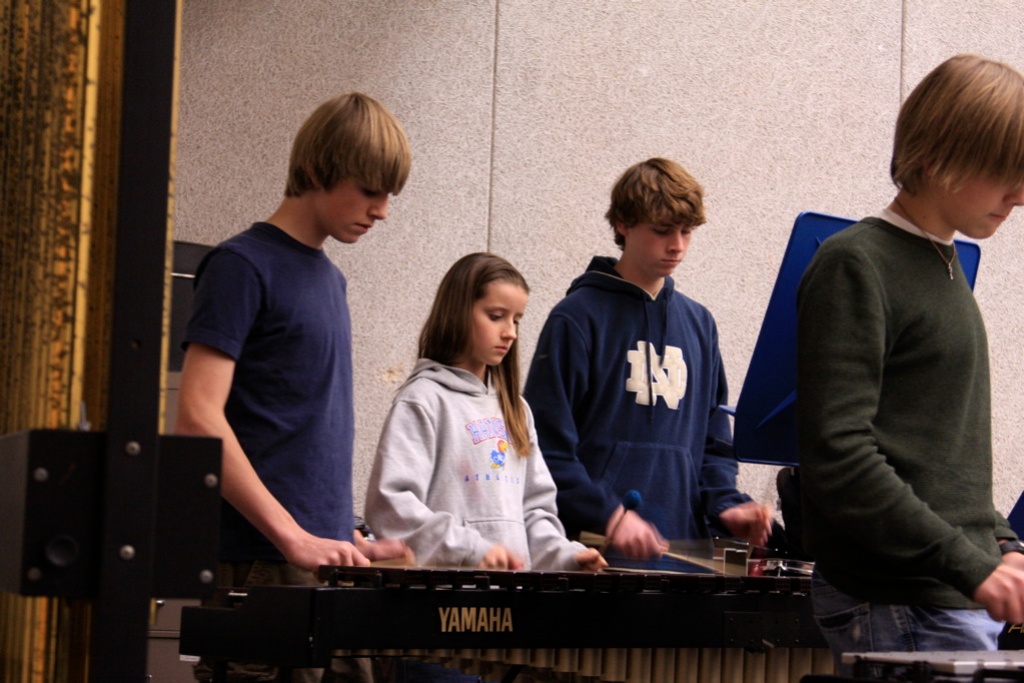March 14, 2008
Writing for young band
Not much to blog about because I’m spending all day, every day, writing a piece for the Hill Country Middle School band — Cheryl Floyd’s band in Austin.
When I told my mother the other day that I was writing a piece for a young band, her response was, “wow, that sounds hard.” No kidding. There’s some definite crap music out there for “grade 3” as it’s called (on a scale of 1-5, with 5, or sometimes 6, being the most difficult technically), and it’s not so hard to write crap music for any age. Writing something worth playing and worth listening to, when, as a composer, you can’t depend on your usual bag of technical tricks, is really challenging. This makes me really admire what the great composers for young band — people like Frank Ticheli come to mind — are able to do.
In reality, I’m not writing a middle school piece. Although Cheryl Floyd’s band is, on paper, a middle school band, they are among the best middle school bands in the country. This is really like writing a piece for a mid-level high school band. Still, there are challenges.
I’m learning a lot about what young musicians can and can’t do, mostly by asking them to do it, then showing the score to somebody who knows how these things work and hearing them tell me, “that’s not even close to possible.” Granted, these suggestions have come not from Cheryl — who can teach her band to do anything I’d ask — but from other directors. I listen to the advice, though, because I don’t even know what’s awkward. I may have written something that’s possible but will take hours of practice, when I could change one note and make it sound basically the same but be less frustrating to learn. What kind of mistakes have I made so far?
I wrote low A’s for baritone sax. Professional bari saxes have a low A on them, but it’s an extension, and it’s not on every instrument — particularly not base-level saxes that would be played by a middle school student. Even if their instrument had the note, it would be the lowest note on the instrument, and the bottom few notes of the sax are problematic, particularly if you want any kind of dynamic control.
I wrote grace notes in the piccolo with pitches that are overly-awkward. I just want a flourish up to a high note, and the pitches I picked were just plain bad. (I wrote G, Ab, Bb, and ending on a C. Much less awkward — and indistinguishable at this speed — is G, A-natural, Bb, C.) As some have told me, this could all be moot, as many middle school bands won’t even have a piccolo player. Cheryl’s band has a great piccolo player.
I wrote high Eb (above the staff), marked mezzo-piano, for the alto sax. As I was told (by a college director, no less), “if you ask most sax players to play the Eb above the staff on the alto sax, you can just ignore your dynamic. If that note comes out at all, it will not be in tune — and it will be louder than anything else happening in the entire band.” So, I shifted the octave.
It was pretty easy to come up with a tune for the piece once I had the rhythmic idea. (The whole piece is in 7/8 alternating with 4/4. It looks tricky on paper, but the subdivision of the 7/8 is always the same — 2+2+3 — so the rhythm is very singable, making it very teachable.) The huge challenge of writing for this level has been the scoring. Because some bands won’t have all instruments — and even if they have somebody holding a given instrument doesn’t necessarily mean you’d want to hear the sound they’d get out of it, and that applies even through college, I’ve found — there aren’t constant solos everywhere. Still, there are a few exceptions. I did write a clarinet solo and a flute solo, but those are safe in almost any band once you reach high school. Since the Hill Country band is so good, I’m going to have a few other solos, too (the oboe part is pretty crucial — not normal for a middle school, to be sure, and I have a section that’s for vibraphone alone — fast and exposed), but the piece can’t be entirely soloistic.
Scoring for young band is a puzzle simply because everything that happens really needs to happen with two different players playing it at the same time, just so it’s covered. Whereas I usually try to approach scoring with some sort of part transparency — lots of color shifts as scoring changes from a flute run to a sax run to a clarinet run, for example — you can’t quite do that with young band, at least not without a little more attention to detail. Without some part transparency, band music starts to sound very “bandy,” so it needs to have some non-tutti work. Want a bass line in the bassoon? It’s a good idea to double it somewhere else, like the bari sax and/or the bass clarinet. (Really, I’d do that anyway. Just look at the ostinato in Redline Tango.) Want a melody in the alto sax alone? It might not be a bad idea to at least cue it elsewhere. (“Cuing” a part means putting it, as an option, in another instrument. That way, if there’s a solo in an instrument like the bassoon and the director doesn’t have a bassoonist or doesn’t think their bassoonist can play that solo, the director can ask the other instrument where it’s cued to play the solo instead.) With this piece, there will be a lot of cues, since the Hill Country group can play the original, but other bands in the future might not be so lucky. So there’s this tricky puzzle of “here’s what I want, ideally, and Hill Country can play it,” with a little bit of “and I’ll cue that here, in case any other band ever wants to try the piece.”
The other challenge, and one where I’m not worrying too much about what I’m writing because Cheryl’s players are so good, is in the percussion writing. I usually write very difficult percussion parts. Most middle school band music gives the percussionists little of interest to do, so I decided to give the percussionists a lot to do. In this piece, they’re playing almost constantly — all six of the players. The mallet parts (there are two of them so far) are very challenging. The parts in this piece can be played with two mallets (one in each hand), but Cheryl’s percussionists can play with four mallets, so I’m not terribly concerned about her players playing this piece. Still, it’s tricky to make sure I don’t go completely overboard. I’m hoping that the percussionists will really like the piece. I’m even giving them a drum break section because they’re so good.
So that’s what’s been keeping me busy. I need to finish the piece by Wednesday, as I’m going to Reno on Thursday to hear the incredible Timothy McAllister perform my soprano sax concerto at a regional CBDNA convention. That will be an exciting trip, but I can’t think about that yet. Right now, I need to finish the piece for Hill Country Middle School — and make sure I don’t let these guys down.
Comments
Cathy says
Hmmm...sounds like another Grade 3 piece that will be out of my band's abilities. Especially if you have 6 percussionists that play constantly. I'm lucky to be able to take 3 percussionists to contest each year! *snaps fingers* Bummer.
~C
Add comment